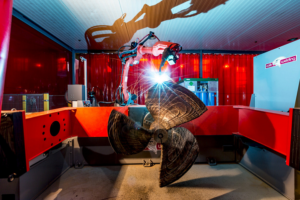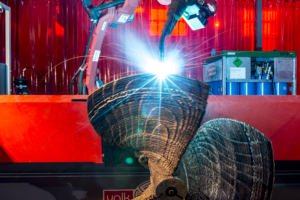 After over half a year of hard work, the 3D printed WAAMpeller – the first-ever ship’s propeller to be class-approved – has finally been verified and unveiled to the public at the Netherlands headquarters of Damen Shipyards Group. The project was announced back in April, when Netherlands-based RAMLAB, an additive manufacturing lab built for the maritime industry in the Port of Rotterdam, revealed its first component, together with software partner Autodesk – a prototype ship’s propeller, built with a hybrid manufacturing approach.
After over half a year of hard work, the 3D printed WAAMpeller – the first-ever ship’s propeller to be class-approved – has finally been verified and unveiled to the public at the Netherlands headquarters of Damen Shipyards Group. The project was announced back in April, when Netherlands-based RAMLAB, an additive manufacturing lab built for the maritime industry in the Port of Rotterdam, revealed its first component, together with software partner Autodesk – a prototype ship’s propeller, built with a hybrid manufacturing approach.
The project grew, working with partners Promarin, Damen, and Bureau Veritas, and set a goal of creating the first class-approved 3D printed ship’s propeller in the world. The 3D printed WAAMpeller is named for the Wire and Arc Additive Manufacturing (WAAM) process used to create it, which is a faster and less expensive 3D printing method and a particular specialty of RAMLAB.
This project was truly a team effort – Promarin designed the WAAMpeller, which features a triple-blade structure similar to the ones on Damen’s Stan Tug 1606 vessel – the same ship used for full-scale operational testing purposes.
Damen also provided R&D resources, while RAMLAB, supported by Autodesk’s additive manufacturing, robotics, and software expertise, took on the task of using its WAAM techniques to fabricate the propeller. Finally, Bureau Veritas verified the whole development, production, and testing process.
“The WAAMpeller project is special for many reasons. Not only has it produced the world’s first class approved 3D printed ship’s propeller, but this has been accomplished within a very impressive seven-month timeframe and only one year after the official opening of RAMLAB,” said Port of Rotterdam CEO Allard Castelein.
“Everyone involved has worked extremely hard to make this happen. Damen, Autodesk and Bureau Veritas have supported the project all the way. Promarin have really shown their expertise with the finishing of this WAAMpeller. And last, but not least, the production process at RAMLAB continued 24/7, with their experts permanently on hand.”
3D printing for the WAAMpeller prototype was completed in September, after required material testing to ensure that the nickel aluminum bronze alloy used was in compliance with Bureau Veritas standards, and it was then sent to Autodesk’s Advanced Manufacturing Facility in the UK for CNC milling. Immediately after it was completed, the collaborative project team began production on a second WAAMpeller, with a goal of achieving class certification.
“Production of the second WAAMpeller was greatly improved because we had learned a lot from producing the prototype. This mainly concerned the hardware/software interaction because, when laying down 298 layers of Nickel Aluminium Bronze alloy, it is important to have a tight control on all process parameters,” said Vincent Wegener, Managing Director RAMLAB.
Once the second WAAMpeller was finished, coming in at about 180 kg, it was put through an extensive testing process, starting with being installed on a Damen Stan Tug 1606.
Martin de Bruijn, Managing Director Workboats at Damen, said, “This particular vessel is of extra interest in that it is equipped with a Tier III compliant engine, making it future proof for the ever stricter environmental rules and regulations in harbours around the world.”

Handing over the BV Certificate (L-R) Jan-Wim Dekker, CPO Damen Shipyards Gorinchem, and Martijn Nieuwenhuijs, Marine and Offshore Chief Executive Bureau Veritas the Netherlands
Operational testing of the WAAMpeller took place last week in Dordrecht, with surveyors from Bureau Veritas on-hand to oversee the process.
“Bureaus Veritas has witnessed every step of the making and testing of the WAAMpeller,” said Martijn Nieuwenhuijs, Chief Executive of Bureau Veritas Marine & Offshore Netherlands. “Some challenges needed to be tackled along the way, but the final product is technically sound and ready for commercial application.”
Representatives from each of the five consortium partners also attended the testing program, which included bollard pull testing, speed trials, and crash stop tests.
“Of course, we were all a bit nervous beforehand – after all, innovation always comes with a certain amount of unknowns – but the testing was a success. We are pleased to report that the WAAMpeller displayed the same behaviour as a conventional casted propeller in all of the tests. This includes the same level of performance in the crash stop scenario, which – going from full throttle ahead to full throttle reverse – is the heaviest loading that a propeller can experience,” said Kees Custers, Damen Project Engineer R&D.
“From day one, this project has been characterised by a good working atmosphere and team dynamics, so there were quite a few high-fives on board when we had successfully completed the tests!”
The completed 3D printed WAAMpeller was officially unveiled today at Damen’s headquarters. While the project showcases the unique abilities of each of the consortium partners, it could also have some major implications on the maritime industry as a whole.
“This project has shown the shipbuilding industry the potential of 3D printing techniques for the production of vessel components,” explained Castelein. “We continue our intensive research into this very exciting area.”
Let us know your thoughts about this story, and other 3D printing topics, at 3DPrintBoard.com or share in the Facebook comments below.
[All images provided by Damen Shipyard Group]
Subscribe to Our Email Newsletter
Stay up-to-date on all the latest news from the 3D printing industry and receive information and offers from third party vendors.
You May Also Like
Precision at the Microscale: UK Researchers Advance Medical Devices with BMF’s 3D Printing Tech
University of Nottingham researchers are using Boston Micro Fabrication‘s (BMF) 3D printing technology to develop medical devices that improve compatibility with human tissue. Funded by a UK grant, this project...
3D Printing Webinar and Event Roundup: April 21, 2024
It’s another busy week of webinars and events, starting with Hannover Messe in Germany and continuing with Metalcasting Congress, Chinaplas, TechBlick’s Innovation Festival, and more. Stratasys continues its advanced training...
3D Printing Webinar and Event Roundup: March 17, 2024
It’s another busy week of webinars and events, including SALMED 2024 and AM Forum in Berlin. Stratasys continues its in-person training and is offering two webinars, ASTM is holding a...
3D Printed Micro Antenna is 15% Smaller and 6X Lighter
Horizon Microtechnologies has achieved success in creating a high-frequency D-Band horn antenna through micro 3D printing. However, this achievement did not rely solely on 3D printing; it involved a combination...


































